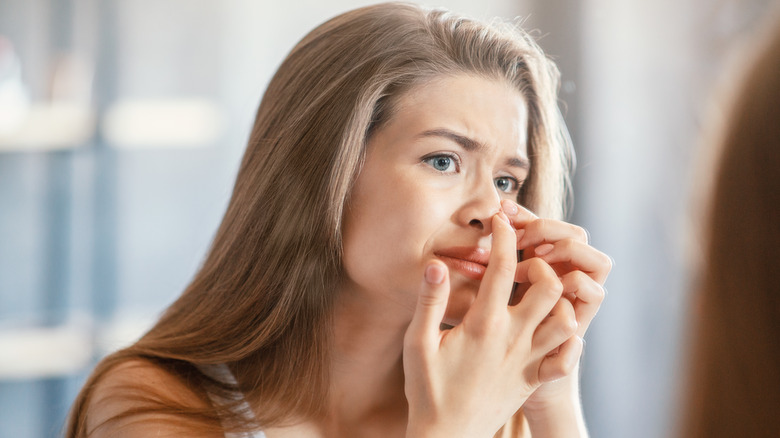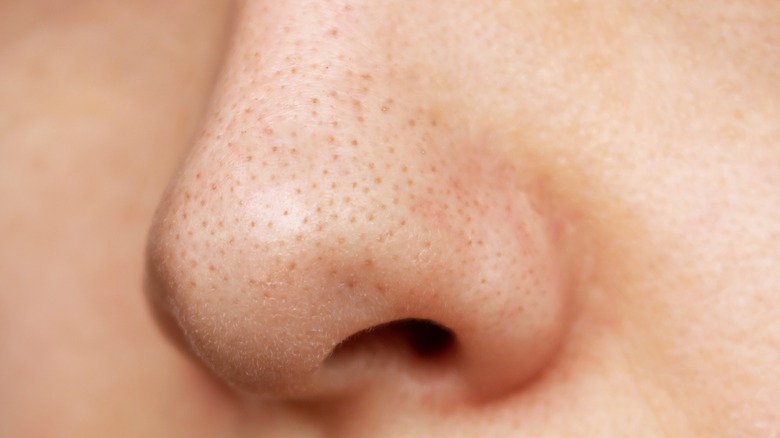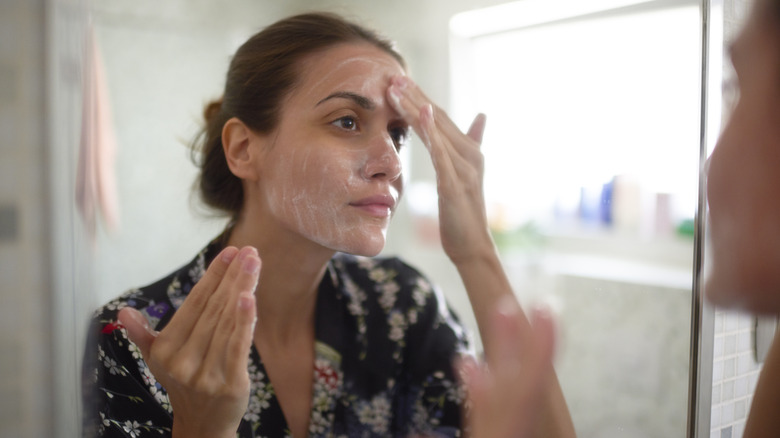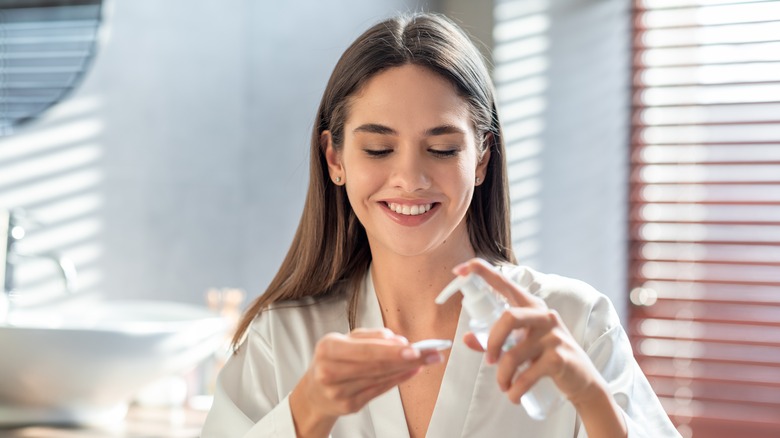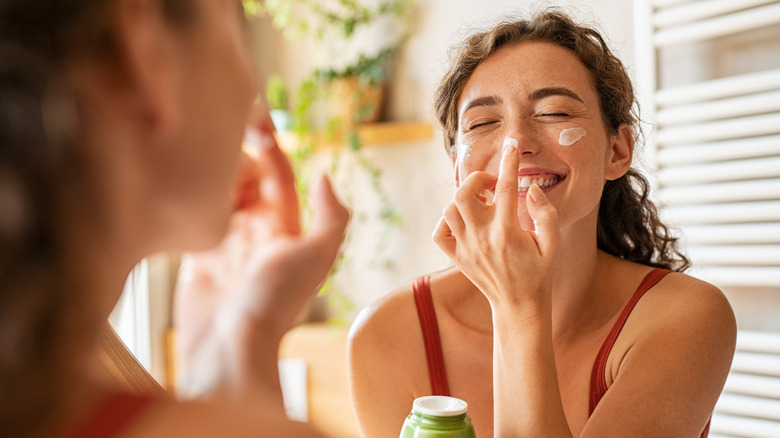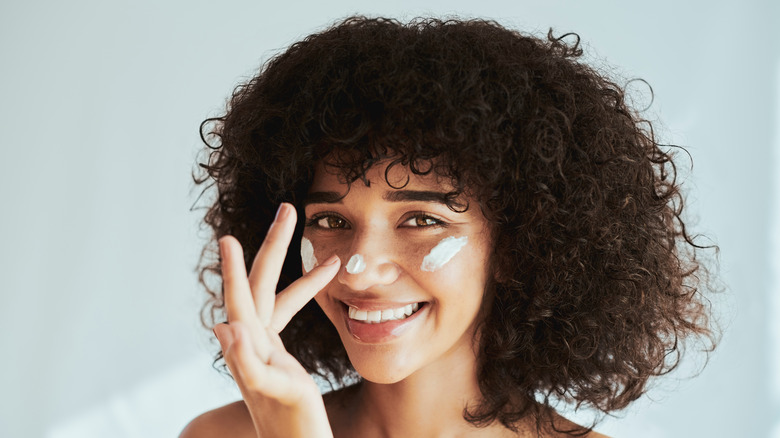How To Regulate Sebaceous Filaments On Your Nose, According To Our Dermatologist
Have you suddenly noticed a group of tiny dark specks on your nose? You may be dealing with something more than run-of-the-mill blackheads. Instead, the dark spots could be sebaceous filaments.
To get the full scoop on regulating sebaceous filaments, Glam spoke exclusively to Dr. Charles, M.D., a board-certified top cosmetic dermatologist in NYC and founder of MOMADerm, a boutique membership-only aesthetic dermatology clinic where he provides natural, understated treatments for his clients. According to Dr. Charles, who provides skincare information and advice on Instagram and TikTok, sebaceous — referring to sebum or oil — filaments are completely normal, so there's no need to worry if you notice these dark specks on your skin out of the blue. "They help to move oil from your pores to the surface of your skin and help keep your skin hydrated," Dr. Charles explains to Glam.
Typically, sebaceous filaments are small and unnoticeable, but they become more noticeable when the skin glands produce excess sebum (via the Cleveland Clinic). As harmless as they are, sebaceous filaments can become unsightly when this happens. Thankfully, there are products you can add to your skincare routine to control the appearance of sebaceous filaments on your nose, chin, forehead, or cheeks. Follow these tips from Dr. Charles to regulate your stubborn sebaceous filaments.
Sebaceous filaments vs. blackheads: What's the difference?
People often confuse sebaceous filaments with blackheads, as they appear similar to the untrained eye. "Sebaceous filaments look like uniform mini gray (to blackish) dots on the nose. This can be contrasted with blackheads, which are a type of acne," Dr. Charles told Glam in our exclusive chat. "A blackhead is when oil/sebum clogs your pores. Blackheads are usually larger, darker in color, and not as symmetrically/uniformly distributed."
Sebaceous filaments, on the other hand, are not classified as acne, per the Cleveland Clinic. They're smaller in size than blackheads and range in color. For instance, they can appear as light yellow, gray, or black. What's more, sebaceous filaments don't prevent oil from moving to the surface of the skin unlike blackhead plugs, which prevent the natural movement of oils.
Because they play a role in your skin's health and hydration, it's best to leave sebaceous filaments alone. Applying pressure to them like a zit can lead to scarring, so it's never recommended (via Healthline). However, treatment is recommended if the sebaceous filaments develop into blackheads.
How to regulate sebaceous filaments
"One of the big myths out there on social media is 'getting rid of your pores,'" Dr. Charles shared exclusively with Glam. This can be a difficult pill to swallow, as a key function of online marketing involves spamming social media feeds with advertisements for products that claim to shrink pores. That said, "[s]ebaceous filaments are a normal part of the skin and nothing will permanently remove them," added Dr. Charles.
"However, we can all understand the desire to want to eliminate those little dark spots. The same things that work for blackheads will actually be effective to [sic] minimizing the appearance of sebaceous filaments," Dr. Charles told us. So, while you can't permanently remove sebaceous filaments, you can make them smaller and less noticeable by tailoring your skincare routine to regulate your sebum production. This will keep the excess sebum in check, which will make the sebaceous filaments less noticeable and also prevent blackheads from forming. A skincare double whammy!
Incorporate salicylic acid into your routine
One of the changes Dr. Charles recommended involves using a product with salicylic acid. "Salicylic acid is a powerhouse ingredient for both of these concerns," Dr. Charles told Glam in our exclusive chat. Salicylic acid is a type of beta-hydroxy acid (BHA) that works deep into the pores to "dissolve the dead skin cells" (via Healthline).
"My favorite way to keep these under control is with a salicylic acid face wash. But apply the wash to the nose for one to two minutes prior to lathering to let the active ingredient work for you," Dr. Charles recommended to Glam. Other common formulations include lotions, ointments, or gels, which work similarly, depending on how strong the concentration is.
For topical treatments or toners, the best way to use salicylic acid in your skincare routine is after cleansing and before serums or moisturizers. After using a product with salicylic acid, remember to follow up with a moisturizer to prevent your skin from drying out and sun protection, as chemical exfoliants generally leave your skin vulnerable to sun damage, per Healthline.
Experiment with glycolic acid
"Beyond salicylic acid, regular exfoliation with glycolic acid can be helpful," Dr. Charles shared exclusively with Glam. Glycolic acid, a type of alpha-hydroxy acid (AHA), exfoliates the dead skin cells that make up the outermost layer of skin.
One main benefit of using glycolic acid is that the former acts as a humectant, per the Cleveland Clinic, which means it both attracts water to and binds to it. As a result, glycolic acid exfoliates and helps keep your skin hydrated. Therefore, products containing glycolic acid shouldn't dry out your skin as much as those containing salicylic acid. The ability for glycolic acid to retain skin moisture suits individuals with dry skin types, while those with oily or acne-prone skin types may prefer salicylic acid. However, sensitive skin may react to glycolic acid and experience symptoms such as swelling, irritation, and hyperpigmentation (via Medical News Today), so always speak to your dermatologist before adding new ingredients and products to your skincare routine.
Try a retinoid
In addition to salicylic acid and glycolic acid, Dr. Charles suggested retinoids for regulating sebaceous filaments. "I also do always recommend my patients use a retinoid — for acne, pores, skin, texture, dark spots, and wrinkles," Dr. Charles explained in our exclusive chat.
Most people associate retinoids with retinol and its wrinkle-fighting perks. However, this vitamin A-derived skincare product offers more benefits for the skin than just its anti-aging ones. Retinoids, such as the sensitive-skin-loving HPR, can help minimize the appearance of sebaceous filaments by preventing clogged pores through exfoliation and higher cell turnover (via Healthline). In other words, incorporating a retinoid into your routine will help stop your pores from getting blocked with excess oil to begin with, which will prevent blackheads from forming and make your sebaceous filaments less noticeable.
However, keep in mind that retinoids require consistent use to notice results. Retinoid use also leaves your skin vulnerable to the sun, so don't forget to apply sun protection after use (and in the morning before leaving the house as a general rule regardless). You should also be mindful of using other active ingredients in your skincare routine, as they can upset the skin when used in tandem with retinoids. For instance, retinol and glycolic acid don't play well together and should be used together cautiously.
'Consistency is key' to regulate sebaceous filaments
As sebaceous filaments are natural components of your skin, they cannot be permanently removed. However, exfoliation and a solid skincare routine can help keep them under control and prevent them from growing larger or more noticeable. "Consistency is key for reducing the appearance of sebaceous filaments. Remember, they are a normal part of your skin and your body is going to continually make sebum," Dr. Charles shared exclusively with Glam.
"The dark/black color occurs when those components are oxidized," Dr. Charles explained. In other words, when sebaceous filaments within the pores are exposed to the air, they become oxidized and grow darker in color — and, therefore, more noticeable. "So, by regularly cleaning out your pores with salicylic acid, glycolic acid, and retinoids, you can reduce the appearance of these filaments," he added. Consistent use of chemical exfoliants or retinoids will help maintain sebum production and prevent blackheads from forming which, in turn, reduces the appearance of sebaceous filaments on your nose, chin, or cheeks.
